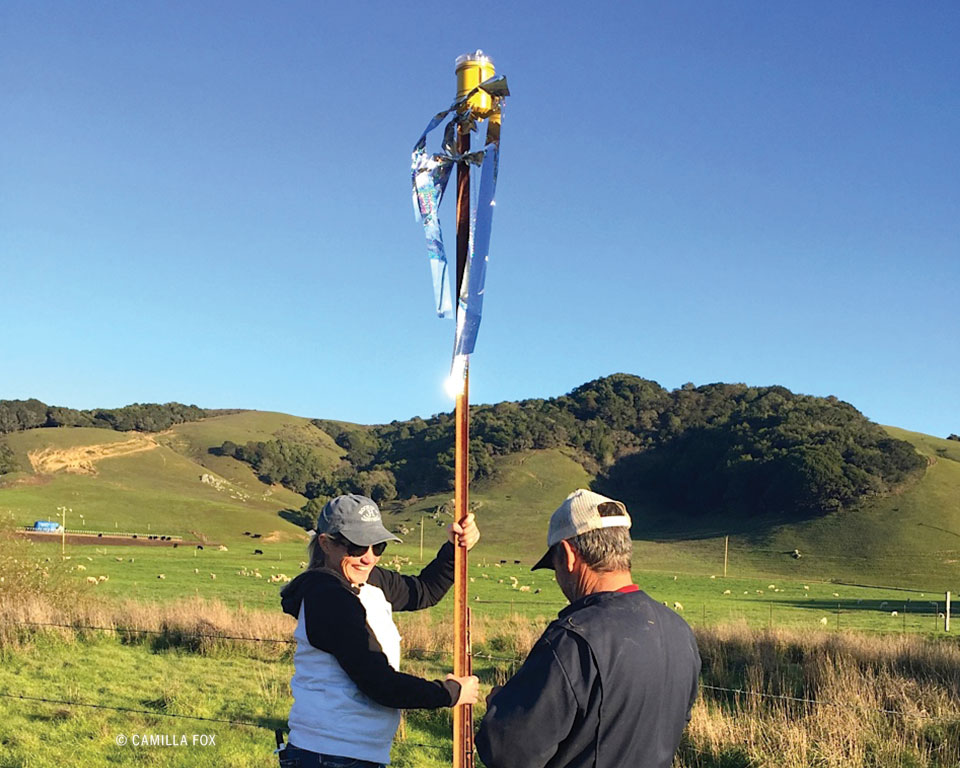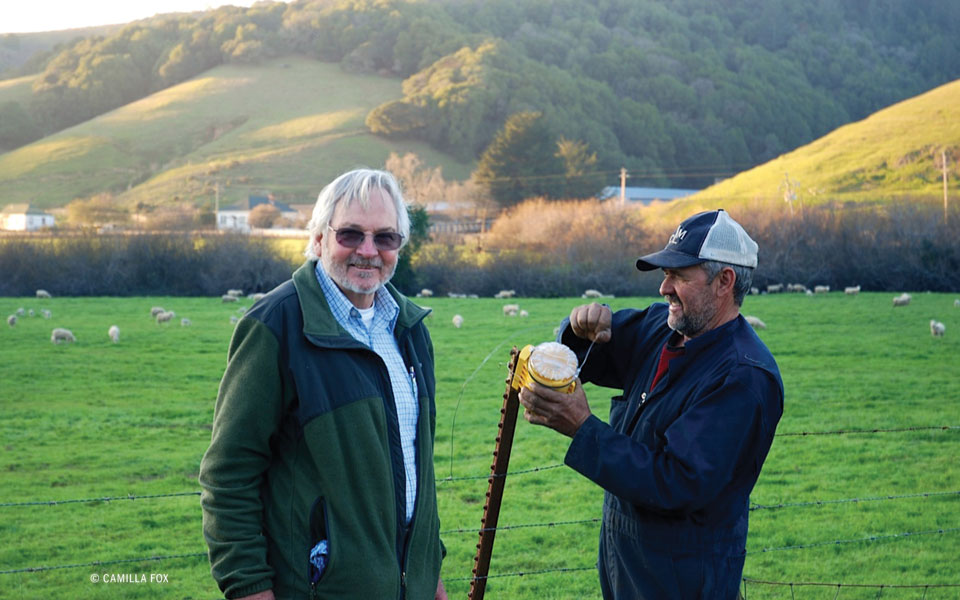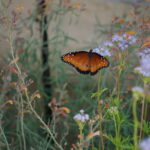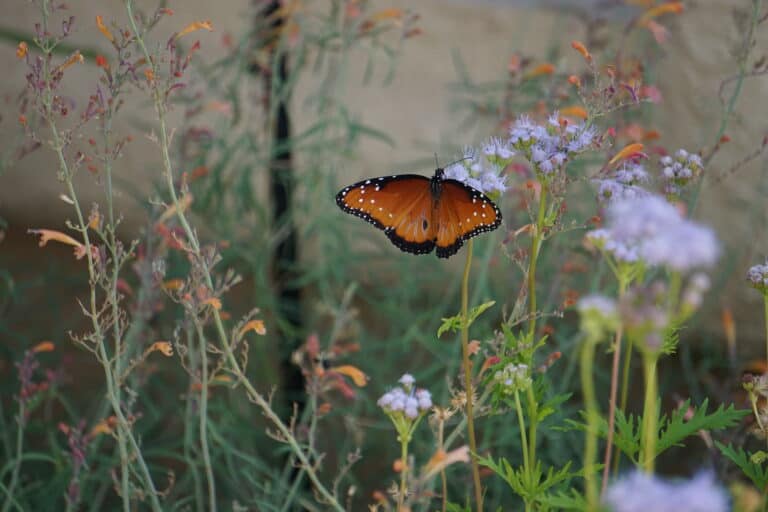Experience and evidence shows that good animal husbandry practices, combined with strategic nonlethal predator control methods, can considerably reduce livestock losses. Project Coyote’s Ranching With Wildlife program assists ranchers with non-lethal livestock protection techniques developed with ranchers and shared in workshops and presentations. Foxlights are quickly becoming a popular non-lethal tool across the U.S., so we asked Project Coyote’s Ranching With Wildlife Coordinator Keli Hendricks to tell us about the history and function of Foxlights and the testing Project Coyote has performed on the predator deterrent device.
What are Foxlights and who invented them?
Foxlights were invented by Ian Whalen, a sheep rancher in Australia, who was losing lambs to foxes. He would get up in the middle of the night and walk through his pastures with a flashlight to scare the foxes away from his sheep. Eventually he realized if he could invent a light that could mimic the look of someone patrolling the pastures with a flashlight, he could sleep through the night. So, this is how Foxlights were born, and they worked so well that Ian even won The People’s Choice Award for Foxlights on the Australian TV show, The New Inventors.
Foxlights come in both battery and solar models, and they operate automatically on a dusk-till-dawn sensor. You place them on a T post or hang them from a tree and they randomly flash LED lights that are projected 360 degrees and can be seen for up to a mile.
Where are Foxlights being used?
In the U.S., state wildlife agencies and private ranchers across the country have been using Foxlights to protect livestock from wolves, coyotes, and other predators. Internationally, they have been used to protect livestock and crops from animals ranging from African elephants to snow leopards. Recently in the U.S., a researcher working on an oil spill used Foxlights to keep wildlife from entering the area of the river where the spill occurred.
So, there are some pretty exciting ways that Foxlights have been used to protect both wildlife and domestic animals.
Why did Project Coyote decide to test Foxlights?
Fauna Tomlinson, who is a Program Associate for Project Coyote, found Foxlights while doing online research for new livestock protection tools. She convinced some ranchers in the U.S. to try them and was getting a lot of positive feedback, so we decided to conduct some testing on them in Marin and Sonoma Counties to see for ourselves how effective they were.
We wanted to be sure that if we were going to recommend a tool, that it was effective and we knew how to use it to achieve the best results.
Where did you test Foxlights, and how was the testing conducted?
We tested Foxlights on four different ranches in Marin and Sonoma Counties in Northern California during the lambing season of 2014, starting in December and ending in March 2015.
The test sites ranged from a hobby farm with under a dozen sheep to ranches over 1000 acres with a few hundred sheep. All the sites already had some non-lethal tools in place, like guardian animals, night corrals or electric fencing. Nevertheless, three of the four were still suffering losses due to various circumstances like being down a guardian dog, or having fencing that needed work. The rancher who was not suffering losses was seeing increased signs of predators, plus their neighbors were losing animals, so they wanted to find a way to make their livestock even less inviting to predators.
For the testing, Dr. Rodney Jackson of the Snow Leopard Conservancy, Fauna Tomlinson and I went to each test site and interviewed the ranchers about the problems they had been having. We showed them how and where to install the Foxlights so they would be most effective, and we placed game cameras in strategic areas to monitor predator activity around the livestock during the testing period. Throughout the testing we stayed in contact with the ranchers so they could let us know what, if any, problems they were having. I also occasionally went to the test sites to change the memory cards in the trail cameras.
What did you see on the cameras?
I went through what must have been thousands of pictures, and even though we used low and no glow infrared cameras (coyotes can be shy of flashes on trail cameras) I didn’t see a single shot of a coyote or mountain lion on the game cameras. I saw a couple of skunks, two raccoons, a hawk, and a few deer. The rest of the photos were either just false triggers, or shots of people and livestock.
One of the ranchers called me during the test and said they thought they lost a lamb to coyotes because it just disappeared. When I reviewed the pictures, instead of seeing a coyote in the pastures stealing lambs, I saw lambs squeezing through a break in the fence to play outside their pasture! It looked like most of the lambs eventually squeezed back through the fence to get back into the pasture with their moms. I don’t know if the missing lamb wandered a little too far away and got grabbed or what, but the rancher fixed the break in the fence and didn’t notice any more missing lambs after that.
What were the results of the testing?
Other than that one wayward lamb, no ranchers reported a loss during the test period. Additionally, every rancher purchased the Foxlights after testing was over, so we felt the anecdotal evidence was strong that the ranchers felt the lights had made a difference for for them.
What do you want ranchers to know about Foxlights?
First, I want them to understand that we are not suggesting that by using a Foxlight you can leave unprotected lambs in a field and they will be safe. But it is a tool that can be very effective when used correctly.
We recommend Foxlights for extra protection during times like lambing season, when animals are more vulnerable. We don’t recommend leaving them out all year long because eventually predators will habituate to them. Other situations where Foxlights can be helpful is when a rancher has a guardian animal that is sick or injured, or when livestock is grazing in areas where guardian animals could use a little more help, or basically, whenever livestock needs a little extra protection for a short periods of time.
What other non-lethal livestock protection tools does Project Coyote recommend?
We always say when it comes to protecting livestock, nothing works better that human presence. Spending more time around livestock not only helps prevent attacks, it also helps ranchers spot animals who are sick, injured or having birthing complications sooner, which can save livestock that otherwise might be lost.
Good fencing, guardian animals, shed lambing and night corrals are other effective methods for keeping livestock safe, in addition to good animal husbandry.
On the technology front, Fauna recently found another promising tool called E-Shepherd collars. They are being used successfully in Africa to protect livestock from jackals, leopards and other predators. You put a collar on one out of every ten sheep and if the sheep move erratically, like they do when they are being chased by a predator, the collars emit flashing lights and an ultrasonic alarm which disrupts the attack. Project Coyote has some of the first E-Shepherd collars in the U.S. and we are collaborating with Hopland Research and Extension Center to test them on their flock.
What do you think is the biggest misconception about non lethal tools?
One of the misconceptions is that if a non-lethal tool isn’t 100 percent effective at preventing predation, then it isn’t worth trying.
I remind people that no tool is 100 percent effective at preventing predation, including lethal ones. Most lethal controls are utilized after livestock is killed, whereas non-lethal tools are proactive and can actually prevent attacks from occurring in the first place. And more and more studies are showing that lethal controls can actually lead to unintended consequences, including an increase in attacks on livestock.
The bottom line is, a tool is only as effective as the person using it. Ranchers have to use the right non-lethal tool for the right circumstance, and it has to be used the right way. Finally, attitude is everything. If a rancher is convinced that non-lethal tools either will or won’t work for them, they will probably be right.
Learn more about more non-lethal techniques, see videos about Foxlights, read an Interview with Ian Whalen and explore additional non-lethal resources.












